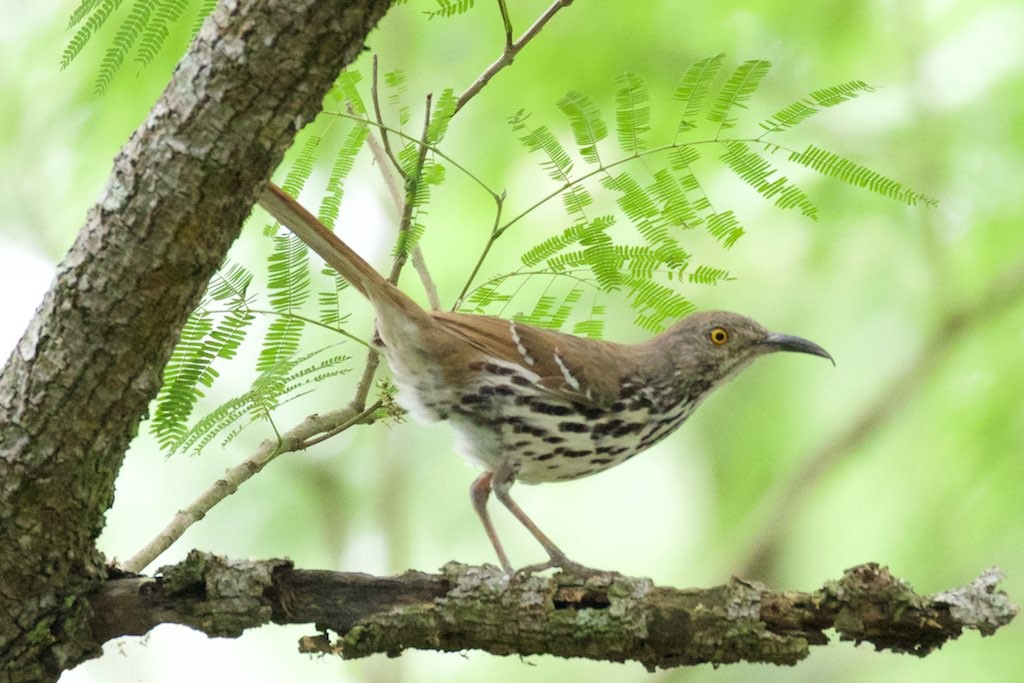Long-billed Thrasher
A species of American Thrashers Scientific name : Toxostoma longirostre Genus : American Thrashers
Long-billed Thrasher, A species of American Thrashers
Botanical name: Toxostoma longirostre
Genus: American Thrashers
Content
Description People often ask General Info
Description
This bird is slender and long-tailed, averaging 26.5–29 cm (10.5–11.5 in) in length and about 70 g (2.5 oz) in weight. It is a large sized thrasher that is close in size to the American robin. T. longirostre ssp. sennitti is described with a grayish-brown crown with a rufous color appearing in the back, rump, rear, and shoulder. Broad white tips located on the greater and lesser primary coverts and dullish-brown with rufous brown edges on the primary and secondary coverts gives the closed wings a rufous appearance. The chin, throat, chest, and belly can appear to be white or a pale-buffy white, although the chest and belly contain keenly blackish oval shapes. The underwing is buffy-white. The iris is typically either orange or orange-yellow, with a dull brown bill with its base of the lower mandible appear to be pinkish grey. T. longirostre ssp. longirostre is similar with an exception to being smaller, darker, and has a red-tinged appearance with buffy-white underparts. Juveniles have dusty streak marks on its rump, with buffy-white undertail coverts. 
Size
29 cm (11.5 in)
Life Expectancy
7 years
Nest Placement
Shrub
Clutch Size
2 - 5 eggs
Feeding Habits
Long-billed Thrasher primarily consumes insects, spiders, snails, and small fruits, foraging by sweeping its bill in broad, sideways strokes through leaf litter on the ground. It is known to toss leaf-litter and excavate soil to uncover prey such as crickets, grasshoppers, beetles, and ants. Seasonally, it eats berries.
Habitat
Long-billed Thrasher thrives in brushlands including dense Tamaulipan thickets and riparian woodlands within southern Texas and north-western Mexico. Showing adaptability, they can occupy human-altered environments like suburbs with sufficient dense vegetation and leaf litter. While resilient, they are still affected by habitat loss and potential range shifts due to climate change.
Nest Behavior
Both long-billed Thrasher parents collaborate in constructing the nest before the breeding season. They follow a pattern of laying eggs in the well-concealed nest and then jointly participate in incubation and rearing the young.
Nest Characteristics
Long-billed Thrasher's nest, placed in dense thickets or small trees, is constructed with thorny twigs, grasses, and other soft materials. The structure typically measures 7.7 inches in width, with an interior cup around 4.1 inches wide and 2.4 inches deep.
Dite type
Omnivorous
General Info
Feeding Habits
Bird food type
Bird Feeder Type

Platform

Ground
Sounds
Song
Recording location: United States
Song
Recording location: United States
Behavior
Long-billed Thrasher exhibit territorial fidelity, with some adjusting their domains seasonally. Interactions between long-billed Thrasher and Brown Thrashers during winter can be contentious, though they typically avoid conflict with other thrashers. Their courtship is similar to the Brown Thrasher's, involving submissive postures and soft vocalizations by the female, accompanied by wing quivering and a nesting material exchange ritual. Both sexes are involved in nest selection, construction, incubation, and chick rearing, showcasing their cooperative breeding nature.
Distribution Area
This species is a resident in southern Texas north to San Antonio and Aranas, south through north-western Mexico to central Veracruz, east to eastern Coahuila, San Luis Potosi and Hildalgo. The breeding density is at the highest among the Rio Grande Valley. Although it is a resident in the lower Rio Grande Valley, a significant amount of its habitat was destroyed for agricultural purposes, and its population in the area decreased from the 1930s to the 1970s. Some human activity that has introduced appropriate habitat is thought to have been some help the species, and it is still is a common resident within its range. In Texas there is some evidence of a northern and eastern expansion of the range over a five decade span (1957-2007), with climate change as the suggested cause. With the exception of vagrants found in New Mexico and Colorado, the species is a permanent resident of its range. 
Species Status
Not globally threatened.
Scientific Classification
Phylum
Chordates Class
Birds Order
Perching birds Family
Mimids Genus
American Thrashers Species
Long-billed Thrasher 